When cruising, there often isn’t a nearby laundromat but there is a pile of dirty laundry. Some boats – the really lucky ones – have a washing machine, large capacity watermaker and the power to support them. Others, like ours, don’t.
So we “hand” wash.
On our first boat, Que Tal, I used a 5-gallon bucket and initially did it all “by hand” as if I were washing delicates. I’d wash each item separately and carefully swish them around.
Yeah, that lasted for exactly one laundry day.
Talking to other cruisers, I learned to use a new (used only for laundry) toilet plunger as an agitator. Infinitely less work and the clothes got cleaner, too!
But the length of the handle on the toilet plunger meant that I was still hunched over the bucket, and it slopped water over the edge of the bucket.
Fast forward to a few months ago. As we were getting ready to leave for the Bahamas, I was going to buy a new toilet plunger to do laundry with as I knew that laundromats could be a distance apart. But somehow I managed to spot an ad for the Washing Wand – supposedly a marked improvement on washing with a plunger. It intrigued me and I bought it.
It’s been a great purchase . . .
- Designed to push water through a bucket a clothes, with water channels that let water go through the device so that water doesn’t slop out of the bucket nearly as much.
- Shovel-type handle makes it much easier to agitate – just an easier, more ergonomic movement.
- Larger diameter means more effective agitation in a 5-gallon bucket.
- More than once, I pulled the wooden handle out of the rubber plunger when using a toilet plunger (and when it happens once, it will keep happening more and more frequently as the rubber stretches). This is all hard plastic with the plunger molded to the handle, and the handle pieces screwing together.
- Yes, it’s in four pieces which make it much easier to store – and they screw together tightly.
- All plastic – no metal to rust or wood to blacken.
- It seems really sturdy – a similar item (different brand) that I saw locally after I’d gotten this one seemed much flimsier and the plastic more brittle.
You can buy one from Amazon –
- Washing Wand – 4-piece hand washing tool
- I’ve found a similar item, the Breathing Mobile Classic Washer, also on Amazon.
Totally disregard their instructions that say you need two 5-gallon buckets – you only need one.
Pictures below, and then tips on how I do laundry:
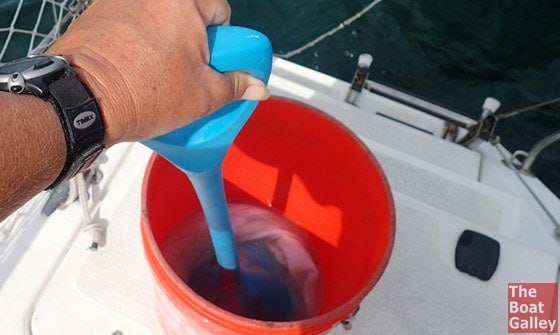
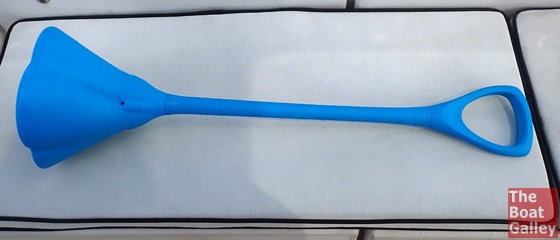
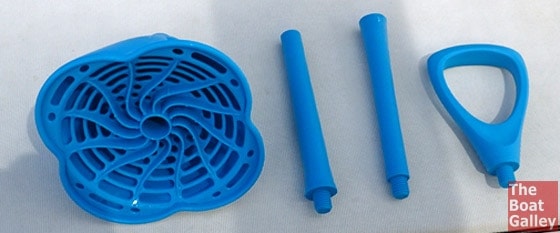
Now, no method of hand washing is going to get clothes as clean as a washing machine does. But my goal is to remove the worst of the dirt, the stink, the mildew and make them fit to wear again.
If you really want to remove stains and are willing to spend the time, a portable washboard is a good extra piece of equipment – use a little bar soap or a stain stick, scrub on the washboard, then wash as usual in the 5-gallon bucket with the Washing Wand. I don’t go through the extra step with our work or sailing clothes, but a couple of people I know use a washboard similar to this one, available on Amazon.
Keeping the laundry pile from getting too big not only helps the boat smell fresh, it helps reduce the mold and mildew on the boat in general (basically, clothes that are wet with sweat just never dry out due to the salt . . . and then you combine that with salt air . . . ). I’m washing sweaty and/or boat-project filthy t-shirts, shorts, undies, rags and our pillowcases. Towels, sheets, rugs, blankets I leave for times when I do find a laundromat.
HOW I DO IT
I try to do laundry every few days so there’s not too much to do – this cuts down on the amount of water I need at one time, makes it easier to wash items and allows for enough drying space (we have lifeline netting so can’t hang wet clothes from the lifelines).
Late one day, I put about one tablespoon of concentrated biodegradable laundry soap in the 5-gallon bucket and add about a gallon of fresh water. Then I add the clothes and more water to cover the clothes if necessary. At this point, it’s okay if the clothes are crammed in. Agitate with the Washing Wand a bit, and then let sit overnight, agitating about 20 strokes periodically (we leave the bucket and wand in the cockpit, so it tends to be when we walk by . . .).
The next morning, I take about half the clothes out, wringing as I do to keep as much water in the bucket as possible – all I’m trying to do is make more room in the bucket (in other words, the clothes I’m taking out aren’t “done” yet). The clothes need space for the water to move through them as I’m agitating!
Then I use the Washing Wand and agitate 100 or so strokes. Then I take these clothes out, wringing as I do (getting as much soapy water out as possible so it doesn’t go in the rinse water later). I put the other clothes back in the bucket and do the same. All the clothes are now washed. I dump the wash water.
I fill the bucket about 4” deep with fresh water and add one or two pieces of clothing at a time and agitate 20 to 30 times to rinse. Then I remove the items and wring well. Dave does another wring after mine and always gets more water out, then he hangs the items to dry. We repeat until everything is rinsed and hung to dry – if the rinse water gets particularly dirty, I discard it and get fresh.
TIPS
A big key is not to use too much soap – if you do, it will take a lot of fresh water to rinse it out. Do not use salt water, even for the washing – you’ll use more fresh water to get all the salt out than it would have taken you to wash the clothes in fresh . . . and if you don’t get all the salt out, your clothes will never completely dry and they will mildew instead.
If you have a little white vinegar to spare, adding 1/4 cup to the rinse water will help cut the soap, but you won’t smell it on your clothes.
If I think about it, putting the soak/wash water into the bucket earlier in the day and letting it sit in the sun gives me warm water to do laundry.
Once upon a time, I used ammonia in the wash water instead of laundry soap — it used less water as you don’t have to rinse ammonia out. I no longer recommend this, for two reasons: it is very hard on clothing and there is controversy over whether putting ammonia into sea water is harmful to fish (specifically their gills) or not and I’d rather err on the side of caution.
ALTERNATIVE
I’ve had several readers ask me about the Wonder Wash – basically, it’s a hand crank washer (see it here on Amazon). I’ve seen a few posts from cruisers on various forums saying they love theirs and others saying they didn’t find it that helpful for the amount of space it took up. I’ve never used one and we just don’t have the space, but it certainly does look interesting.
Flatten the learning curve with practical how-to info that gives you the confidence to step into life aboard.
Start Learning Today

Carolyn Shearlock has lived aboard full-time for 17 years, splitting her time between a Tayana 37 monohull and a Gemini 105 catamaran. She’s cruised over 14,000 miles, from Pacific Mexico and Central America to Florida and the Bahamas, gaining firsthand experience with the joys and challenges of life on the water.
Through The Boat Galley, Carolyn has helped thousands of people explore, prepare for, and enjoy life afloat. She shares her expertise as an instructor at Cruisers University, in leading boating publications, and through her bestselling book, The Boat Galley Cookbook. She is passionate about helping others embark on their liveaboard journey—making life on the water simpler, safer, and more enjoyable.
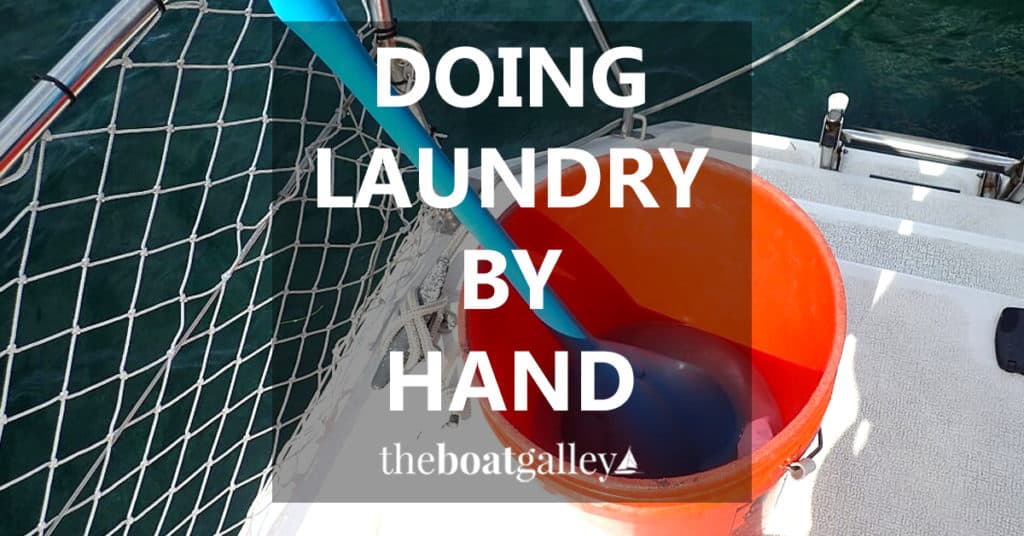







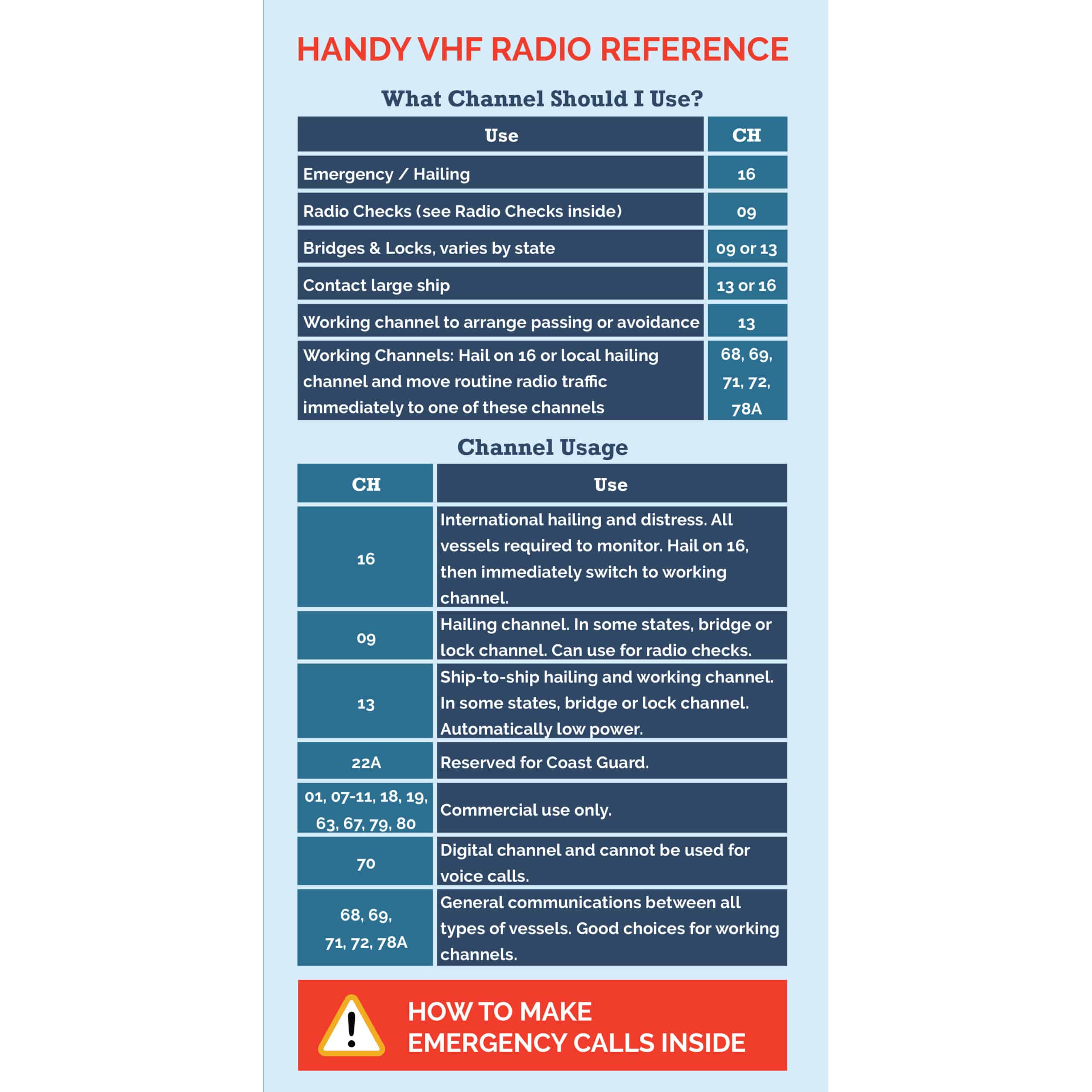

Jan Peck Anderson says
I have one that was my grandmother’s probably from the thirties.
Jan Bogart says
Always look at these, wondering if they are good. The ammonia thing always seemed strange with no rinse…..filthy looking water.
Laine Common says
It was alright, but it snapped the first time my husband used it. I would rather pay more for a better made one. Now we have a Splindide washer dryer combo unit though.
The Boat Galley says
Snapped? Wow. I wouldn’t have thought that possible. Guess I’m just not THAT strong! I’ll watch out if I ever doing washing after eating my Wheaties . . .
Laine Common says
Yeah.. In all fairness, he is a bit on the “don’t know your own strength” side..
Cherrie-Anne Mountford says
This was helpful. Thanks.
Taunya Couts says
I have been using something similar, but I had to provide my own handle… (although the ads show it coming with one.)
In addition to that, I use a commercial salad spinner to spin dry my clothes… It actually works pretty well… Although your double wring is probably just as effective. I’m lazy and don’t like to wring so hard…
http://amzn.to/290vf6V
John Colley says
and gives an extra half knot down wind
Cookie johnson says
I have watched this foot pedal video many times and wondered if this would be a good item to take. Has anyone used of these? http://www.gizmag.com/yirego-drumi-foot-powered-washer/37586/
Cookie says
I forgot to check for replies! Thank you
Carolyn Shearlock says
The last I knew, that was in development and not on the market yet. Looks interesting but again, we just don’t have the room. Larger boat? Sure, I think it would be great!
Kathy Nee says
I just ordered mine! Delivery in early January… It’s a startup company so production is small. It has Won several awards. It is about as big as a five gallon pail. It washes, rinses and spins water out …
Carolyn Shearlock says
Oooh, great to know!
Cookie says
Please let us know how it works when you get it!
Kathy Nee says
I’ll let you know… Long wait though
Jake says
Any news on this? 🙂
J Crysler says
Anyone tried the Scrubba Wash Bag? A dry bag with nodules inside that do the scrubbing for you. Sounds intriguing , Amazon $60.
Carolyn Shearlock says
I wrote an article about it with readers experiences . . . the concensus seems to be that it might be good for backpacking or canoeing trips, but there are better options on a boat.
J Crysler says
Thanks Carolyn. I decided I’d make my own with a dry bag and dryer balls, I’ll let you know how that works, or not. Always have the trusty bucket.
Charles says
When I was aboard the tall ships Picton Castle and Kwai, we all did laundry by hand in 5-gal buckets. No fancy plungy thingies to be found. Typical procedure on both is salt water wash (any detergent works fine in salt water), salt water rinse, fresh water rinse. It works a treat, but I certainly wish I didn’t have to hunch over a bucket while washing. I thought many a time about getting a toilet plunger and modifying it with slots. Both ships are quite large enough to store them away but, on both ships, the plunger would likely be repurposed for something you don’t want to clean your clothes with ever again.
Picton Castle has two “laundry halyards” for raising and lowering the drying lines (each three 10′ lines stretched across three sticks on the foredeck). No clothes pins; just jamb your clothes in between the strands of the three-strand hemp lines. The harder the wind blows, the tighter it grips your laundry. Wonderful.
Jessica Heinicke says
Great information! Thanks! I find one helpful piece of equipment for hand washing has nothing to do with the washer – it’s a laundry wringer. I have a powder coated cast iron old fashioned wringer with two rollers and a crank. I put the clothes through after rinsing and it gets 90% of the water out. The clothes are almost dry enough to put away! And it saves the strain on my paws…
tami says
I bought an antique wringer on eBay after reading several reports that the wringer is more useful than one of those laundry pods etc. aboard
I bought mine for, I think it was $60 with shipping and all? The new wringers are pretty expensive and this one seems to do the job. The trick is finding somewhere to mount it. We’re also looking at modifying the handle receptacle to take a sailboat winch handle 🙂
Tami says
Update: figured how to get it rigged by clamping it to a bit of 2×4 clamped to the boat. The real nifty mod was that we had a socket machined so the wringer can take a winch handle. One of the perks of being in the oilfield
Alene D. Rice of s/v Migration says
Throughout my 12 years of cruising, I’ve always done laundry by foot. When I began cruising, I had symptoms of carpal tunnel in both wrists; plus, my legs are much stronger than my arms, so I have a bucket large enough to fit both feet in, & I stomp away. It works great, & the big wide-mouth basin that I use doubles as a rinse bucket for dive gear, for rain catchment, & could also be used as a bathtub for kids.
Also, because wringing is sometimes painful for me, I simply don’t do it. I dump the clean, wet laundry on deck & stomp on it some more. A surprising amount of water comes out this way, & the rest comes out by the drip method. As a cruising friend from Alabama once said to me, “We’ve done the washing; let God do the drying!” (That goes for dishes, too…)
Diane says
I was wondering if anyone uses a clothes wringer? Why or why not?
Lamarr Harding says
I have a large sturdy salad spinner. I start with about a gallon of water and a squeeze of soap/detergent. I wash 2 or 3 pieces of underwear, a long sleeve shirt, or long trousers at a time. Starting with whites, then pastel, finally darks. Put the item(s) in the spinner, pull the rope once or twice, let soak 5 minutes (or until I remember it) pull the rope again. Dump the soapy water into a bucket to be saved for the next items. Put the lid back on and pull the rope again, dump and spin again until relatively dry. Look for spots on items and rub with bar soap until spot dissappears. Now for the rinse water, add a dash of white vinegar, and fill to cover the cloths. Pull the rope a couple times, dump the rinse water in a different bucket to be saved, spin and dump untill you are satisfied your garment is dry enough to hang. Start the next item (s) reusing the wash and rinse water.
If things get bloody or greasy do 2 washes, first warm (so the stains don’t set), then a hot soapy water with more soap, soaking and agitating until it comes clean
YouTube Alaska Granny has a video on it.
Thanks
DrJuan says
There is a heavy duty plastic five gallon spinner for cloths, as well as a hand crank wringer if you prefer, at Lehmans Non-Electric. teh five gallon spinner bucket might suffice for the washing step as well. Pricey but will last a long time:
https://www.lehmans.com/search?w=clothes+wringer
they also sell an 18 dollar plunger washer:
https://www.lehmans.com/search?w=clothes+washer
.
StarWish246 says
You can use a regular plunger, just drill a few small/medium size holes in 3 or 4 places in the plunger for the air to get out, and the water to take over the space, as you use it.
StarWish246 says
Just a thought – drill the 3 or 4 holes in the bottom part of the plunger bell (away from the stick), because if the holes are higher up, the water pushed through during plunging will spray upwards, and maybe out of the bucket.
Kathryn says
I have a mid sized rubbermaid bin that I fill partially with water, laundry soap and a load of clothes. I put it in the cockpit, don my bathing suit, crank up the tunes, and hop in. I dance a few songs on the clothes until the “cycle” is over. Then I wring out the clothes and place into a pile. I repeat with a second wash load if necessary. Then I start with fresh water and repeat with a rinse cycle and more dancing. When all is rinsed and wrung, I string up lines in the rigging, hang it all up, and get in the hammock with a cold drink to watch it dry. Exercise and clean clothes!
Chris H says
Years ago, last century, on a smaller cat (35ft) we used an 80 litre wide mouthed barrel with a screw lid – also in the days before getting a water maker. At the same time we also had a small mains wash machine and a small Italian spin drier that each drew around 150watts. We usd very little water. Whilst sailing we literally did nothing when we used the barrel as the motion did all the work. We then graduated to a small twin tub wash machine. We always used the spinner to get the soapy water out before rinsing. We now have a bigger water maker and an automatic top loading washing machine that runs from our invertor (we dont have a diesel gen set).
Christine Lubimir says
We have a washer dryer combo that barely washes and doesn’t dry no matter how long it runs. Fellow cruisers swear by the Panda washers which are small portable electric washers available on Amazon.. I’m a little nutty about clean clothes so I admit I have been referred to as the laundry boat more than once.! I agree small amounts of soap are key and I add a small amount of softener to the first rinse..
Allyson Way says
Hi, I use a washing system similar to your set up, however, I then use a portable spin dryer in order to eliminate the water. Living in the Pacific North West means that rain is likely throughout the year and getting the washing dry can be a nightmare. The spin dryer (http://amzn.to/2pteuN3) can be used both at dock and from our 12v backup system, I have been using this for the past year and am more than happy.
Chris H says
We bought the hand cranked wash machine many years ago – it is too tiny to be of meaningful use. At the time we were on a 35ft Cat and later bought a small (120w.230v) wash machine and a 140w/230v spin drier. I regret leaving them on that boat when we sold. Nowadays, with a bigger cat, we have an automatic wash machine (but no generator) which runs via the invertor/solar and water maker.
Diane Mercaldo says
After reading many of your articles regarding your trip to the Bahama’s we purchased a clothes wringer and the wash agitator. The clothes wringer saved so much time and the clothes would be almost dry by the time I hung them. I ended up having a makeshift clothes line in the cockpit of our monohull. No worries of having clothes disappear over the side,pins break or rust spots.
Corinne Verpoorten says
Any recommendations for the best clothes wringer to use on board, and where to buy it?
Carolyn Shearlock says
I haven’t used one myself as my husband has always been willing to hand wring. I think one would be great!
Tami Klassen says
I think our old wringer is a ‘Majestic.’ It’s not a big wooden job; just the rollers and clamps, pretty much
Another perspective
http://maiaaboard.blogspot.com/2012/08/through-wringer.html?m=1
Anonymous says
On the PNW drying your laundry is more of a problem. Wringing clothes out by hand does not get enough water out. I purchased
a small wringer designed for car wash rags. It was easily clamped to cockpit comings. Even will wring out a pair of denim jeans!
The Boat Galley says
Great to hear! What brand? Is it working well?
Anonymous says
The Boat Galley Amazon: Dynajet Chamois and towel wringer. $148.. Worked great, only problem it rusts. Sorry I don’t know how to do a link
Carolyn Shearlock says
Here’s the link: https://amzn.to/2IATeeX (Update: The Dynajet is not currently available on Amazon but this wringer is highly rated: https://amzn.to/2MIWJW4.)
Anonymous says
The Boat Galley Dynajet Chamois & Towel Wringer. 148.50 +shipping on Amazon. Sorry I don’t know how to post a link. It workes great, used on trip to northern BC. Lots of rain. Only drawbac is that the metal parts rust. I keep in a bag with dessicants
Carolyn Shearlock says
Here’s the link: https://amzn.to/2IATeeX
The Boat Galley says
Here’s the link to that one: https://amzn.to/2qgfbt5
The Boat Galley says
And I also noticed this one that’s made of stainless so won’t rust: https://amzn.to/2HgZMQw
Anonymous says
Jamie Bradley
Anonymous says
Lynda Schoenauer
Molly sv Sabai says
I have the old low-tech plunger with holes drilled in it. The holes are helpful. I also have one of the fangled sonic gizmos that you can put in a bucket or the galley sink. I’m not thrilled with the sonic thingee.